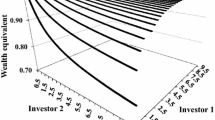Summary
Recently it has been shown that a corporation maximizing the market value of its shares does not necessarily maximize the welfare of its shareholders. It is assumed that the shareholders have either quadratic or exponential utility functions and identical future expectations. This paper drops these assumptions and analyzes in general the conditions under which market value resp. wealth maximization is compatible with welfare maximization. It will be shown that conflict and compatibility of these objectives depend on the degree of relative risk aversion of the shareholders.
Zusammenfassung
Kürzlich wurde gezeigt, daß ein Unternehmen, das den Marktwert seiner Aktien maximiert, nicht unbedingt die Wohlfahrt seiner Aktionäre maximiert. Dabei wurde unterstellt, die Aktionäre hätten entweder quadratische oder exponentielle Nutzenfunktionen und gleiche Zukunftserwartungen. Hier werden unter Aufgabe dieser Annahmen die Bedingungen analysiert, unter denen Marktwert bzw. Reichtumsmaximierung mit Wohlfahrtsmaximierung kompatibel ist. Es wird gezeigt, daß Konflikt und Kompatibilität dieser Ziele von der Höhe der relativen Risikoaversion der Aktionäre abhängen.
Similar content being viewed by others
References
Adler, M.: On the Risk-Return Trade-Off in the Valuation of Assets, in: Journal of Financial and Quantitative Analysis,4, 493–512, 1969.
Arrow, K. J.: Aspects of the Theory of Risk Bearing, Helsinki (Finnland), 1965.
Ebel, J.: Optimality of Stock Market Allocation: Notes of Discussion. Discussion paper, Saarbrücken, 1973.
Franke, G.: Verschuldungs- und Ausschüttungspolitik im Licht der Portefeuilletheorie, Köln et al. 1971.
Hirshleifer, J.: Investment, Interest and Capital, Englewood Cliffs, N. J., 1970.
Laux, H.: Kapitalkosten und Ertragsteuern, Köln et al. 1969.
—: Expected Utility Maximization and Capital Budgeting Subgoals, in: Unternehmensforschung15, 130–146, 1971.
Lintner, J.: Security Prices, Risk and Maximal Gains from Diversification, in: Journal of Finance20, 587–615, 1965.
Long, J.: Wealth, Welfare, and the Price of Risk, in: Journal of Finance27, 419–433, 1972.
Mossin, J.: Equilibrium in a Capital Asset Market, in: Econometrica,34, 768–783, 1966.
—: Optimal Multiperiod Portfolio Policies, in: Journal of Business41, 215–229, 1968.
Pratt, J.: Risk Aversion in the Small and in the Large, in: Econometrica,32, 122–136, 1964.
Rothschild, M., andJ. E. Stiglitz: Increasing Risk: I. A Definition, in: Journal of Economic Theory2, 225–243, 1970.
Sharpe, W.: Capital Asset Prices: A Theory of Market Equilibrium Under Conditions of Risk, in: Journal of Finance19, 425–442, 1964.
Stiglitz, J. E.: Optimality of Stock Market Allocation, in: Quarterly Journal of Economics86, 25–60, 1972.
Whitmore, G. A.: Market Demand Curve for Common Stock and the Maximization of Market Value, in: Journal of Financial and Quantitative Analysis5, 105–114, 1970.
Author information
Authors and Affiliations
Rights and permissions
About this article
Cite this article
Franke, G. Conflict and compatibility of wealth and welfare maximization. Zeitschrift für Operations Research 19, 1–13 (1975). https://doi.org/10.1007/BF01958595
Received:
Issue Date:
DOI: https://doi.org/10.1007/BF01958595




